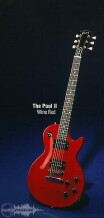View other reviews for this product:
« A rare and excellent guitar from the Masters of Mahogany »
Published on 09/27/12 at 16:57In the late 70's, Gibson introduced a model called The Paul in what was known as the "Firebrand Series" of guitars. It sported a thinner, smaller Mahogany body than the typical Les Paul model, and even slightly smaller than the Les Paul Studio. The toggle switch was relocated near the control knobs, and the top edge of the body was beveled. The headstock bore a slightly sharper, more exaggerated profile.
Aside from that, it featured the standard Gibson profile neck with 22 frets and 24.75 scale length with a 9.5in radiused rosewood fingerboard. All for a price significantly under what a Les Paul Standard went for. It also sported the same 490R/498T humbucker configuration of the Standard, along with the familiar 2 Volume/2 Tone controls.
Gibson discontinued The Paul in the early 80's and it didn't reappear again until the late 90's when Gibson revamped The Paul by putting the toggle switch back in the familiar Les Paul location, and doing away with the radical body contour in favor of a more typical Les Paul-style carved top. The headstock was also returned to the more typical Gibson dimensions. This new model was dubbed The Paul II. Production was discontinued in 1999 and has not resumed since, making this model just as rare, if not moreso, than its early Firebrand incarnation.
UTILIZATION
The Paul II is very light compared to, well, most Gibson guitars. It makes a great Les Paul for those with a bad back, or those of the smaller and/or younger crowd. Nevertheless, the neck is full sized, full scale with decent access to the upper frets. The guitar itself is full and resonant even when unplugged, thanks to a solid mahogany body and set mahogany neck.
The Paul II features all the standard hardware present on the more expensive Les Paul Standard, even down to the Switchcraft output jack and Gibson pearloid keystone tuners. Gibson did not compromise on quality where they compromised on size.
SOUNDS
I've played The Paul through literally hundreds of amps and setups, and it's been a constant, familiar musical companion for more than 12 years. It immediately sounds like itself through any amplifier, and can and has easily pulled off everything from the cleanest, smoothest jazz to the most brutal metal allowed on a 6-string.
Even after having its headstock repaired when it snapped during a nasty fall, it sounds like it did the day I brought it home, and plays even better.
I've since replaced the neck pickup with a Seymour Duncan SH-2 after the Gibson 490R failed, and I've also replaced two of the pots and the tuning keys, it's still going strong, albeit incredibly beat up. I'm hard on my guitars!
OVERALL OPINION
Gibson, in my opinion, made a mistake when they discontinued The Paul II after only a couple of years' production. It was and is an incredible value that would be well received in today's economy. Perhaps I should write them a letter and see if I can inspire yet another run of this great guitar.
Aside from that, it featured the standard Gibson profile neck with 22 frets and 24.75 scale length with a 9.5in radiused rosewood fingerboard. All for a price significantly under what a Les Paul Standard went for. It also sported the same 490R/498T humbucker configuration of the Standard, along with the familiar 2 Volume/2 Tone controls.
Gibson discontinued The Paul in the early 80's and it didn't reappear again until the late 90's when Gibson revamped The Paul by putting the toggle switch back in the familiar Les Paul location, and doing away with the radical body contour in favor of a more typical Les Paul-style carved top. The headstock was also returned to the more typical Gibson dimensions. This new model was dubbed The Paul II. Production was discontinued in 1999 and has not resumed since, making this model just as rare, if not moreso, than its early Firebrand incarnation.
UTILIZATION
The Paul II is very light compared to, well, most Gibson guitars. It makes a great Les Paul for those with a bad back, or those of the smaller and/or younger crowd. Nevertheless, the neck is full sized, full scale with decent access to the upper frets. The guitar itself is full and resonant even when unplugged, thanks to a solid mahogany body and set mahogany neck.
The Paul II features all the standard hardware present on the more expensive Les Paul Standard, even down to the Switchcraft output jack and Gibson pearloid keystone tuners. Gibson did not compromise on quality where they compromised on size.
SOUNDS
I've played The Paul through literally hundreds of amps and setups, and it's been a constant, familiar musical companion for more than 12 years. It immediately sounds like itself through any amplifier, and can and has easily pulled off everything from the cleanest, smoothest jazz to the most brutal metal allowed on a 6-string.
Even after having its headstock repaired when it snapped during a nasty fall, it sounds like it did the day I brought it home, and plays even better.
I've since replaced the neck pickup with a Seymour Duncan SH-2 after the Gibson 490R failed, and I've also replaced two of the pots and the tuning keys, it's still going strong, albeit incredibly beat up. I'm hard on my guitars!
OVERALL OPINION
Gibson, in my opinion, made a mistake when they discontinued The Paul II after only a couple of years' production. It was and is an incredible value that would be well received in today's economy. Perhaps I should write them a letter and see if I can inspire yet another run of this great guitar.


